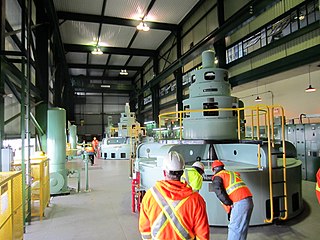
Hydro-Québec is a Canadian Crown corporation public utility headquartered in Montreal, Quebec. It manages the generation, transmission and distribution of electricity in Quebec, as well as the export of power to portions of the Northeast United States. More than 40 percent of Canada’s water resources are in Quebec and Hydro-Québec is the fourth largest hydropower producer in the world.

Hydro One Limited is an electricity transmission and distribution utility serving the Canadian province of Ontario. Hydro One traces its history to the early 20th century and the establishment of the Hydro-Electric Power Commission of Ontario. In October 1998, the provincial legislature passed the Energy Competition Act which restructured Ontario Hydro into separate entities responsible for electrical generation, transmission/delivery, and price management with a final goal of total privatization.

New Brunswick Electric Power Corporation, operating as NB Power, is the primary electric utility in the Canadian province of New Brunswick. NB Power is a vertically-integrated Crown corporation by the government of New Brunswick and is responsible for the generation, transmission, and distribution of electricity. NB Power serves all the residential and industrial power consumers in New Brunswick, with the exception of those in Saint John, Edmundston and Perth-Andover who are served by Saint John Energy, Energy Edmundston, and the Perth-Andover Electric Light Commission, respectively.

The electricity sector in Canada has played a significant role in the economic and political life of the country since the late 19th century. The sector is organized along provincial and territorial lines. In a majority of provinces, large government-owned integrated public utilities play a leading role in the generation, transmission, and distribution of electricity. Ontario and Alberta have created electricity markets in the last decade to increase investment and competition in this sector of the economy.

The Chaudière Falls, also known as the Kana:tso or Akikodjiwan Falls, are a set of cascades and waterfall in the centre of the Ottawa-Gatineau metropolitan area in Canada where the Ottawa River narrows between a rocky escarpment on both sides of the river. The location is just west of the Chaudière Bridge and Booth-Eddy streets corridor, northwest of the Canadian War Museum at LeBreton Flats and adjacent to the historic industrial E. B. Eddy complex. The islands surrounding the Chaudière Falls, counter-clockwise, are Chaudière Island, Albert Island, little Coffin Island was just south of Albert Island but is now submerged, Victoria Island and Amelia Island,, Philemon Island was originally called the Peninsular Village by the Wrights but became an island when the timber slide was built in 1829 it is now fused to south shore of City of Gatineau, and Russell Island, now submerged, was at the head of the Falls before the Ring dam was built. The falls are about 60 metres (200 ft) wide and drop 15 metres (49 ft). The area around the falls was once heavily industrialized, especially in the 19th century, driving growth of the surrounding cities.
The Canadian International Paper Company (CIP) was a Montreal-based forest products company, a former subsidiary of International Paper. It was originally formed as the St. Maurice Lumber Company in 1919 but was renamed in 1925. It was sold to Canadian Pacific Forest Products in the early 1980s, which became Avenor Inc. in 1994; this company was then bought by Bowater in 1998.

Established in 1898, the Shawinigan Water & Power Company was one of the dominant, privately owned hydroelectric companies in Canada until 1963, when it became a part of Hydro-Québec.

Hydro-Québec's electricity transmission system is an international electric power transmission system centred in Quebec, Canada. The system pioneered the use of very high voltage 735-kilovolt (kV) alternating current (AC) power lines that link the population centres of Montreal and Quebec City to distant hydroelectric power stations like the Daniel-Johnson Dam and the James Bay Project in northwestern Quebec and the Churchill Falls Generating Station in Labrador.
Énergir, formerly known as Gaz Métro, is an energy company with 535,000 customers in Quebec and the northeastern United States. It is the largest natural gas distribution company in Quebec, and, through subsidiaries, also produces electricity from wind. In the United States the company operates through subsidiaries in seventeen states, where it produces electricity from hydroelectric, wind and solar sources, in addition to being the leading electricity distributor and the sole natural gas distributor in Vermont.
Hydro-Québec is a government-owned public utility established in 1944 by the Government of Quebec. The company is in charge of the generation, transmission and distribution of electricity across Quebec. Its head office is located in Montreal.
The Champlain Hudson Power Express (CHPE) is a planned high-voltage direct current (HVDC) underwater and underground power cable project linking the Quebec area to the New York City neighborhood of Astoria, Queens. Following completion of a review by the New York State Public Service Commission, construction began in 2022. The line is permitted and expected to be operational in 2026.
The McCormick generating station is a dam and power station built on the Manicouagan river by the Quebec & Ontario Paper Company and the Canadian British Aluminium Company 3 km (1.9 mi) west of Baie-Comeau, Quebec, Canada. It is named after colonel Robert R. McCormick (1880–1955), who owned and published the Chicago Tribune.
The Bersimis-1 generating station is a dam and a hydroelectric power station built by Hydro-Québec in conjunction with Perini, Atlas and Cartier construction companies on the Betsiamites River, in Lac-au-Brochet, 85 km (53 mi) north of the town of Forestville, Quebec. Construction started in 1953 and the power station was commissioned in 1956 with an initial nameplate capacity of 912 megawatts.
The Bersimis-2 generating station is a dam and a run-of-the-river hydroelectric power station built by Hydro-Québec on the Betsiamites River, in Lac-au-Brochet, 66 km (41 mi) north of the town of Forestville, Quebec. Construction started in 1956 and the power station was commissioned in 1959 with an initial nameplate capacity of 655 megawatts.

The history of electricity sector in Canada has played a significant role in the economic and political life of the country since wide-scale industrial and commercial power services spread across the country in the 1880s. The development of hydropower in the early 20th century has profoundly affected the economy and the political life in Canada and has come to symbolize the transition from "old " industrialism of the 19th century to a "new", modern and diversified, Canadian economy.

The Menihek Hydroelectric Generating Station is a conventional hydroelectric generating station at Menihek Lake in Labrador. The dam and powerhouse are located in the Canadian province of Newfoundland and Labrador, 40 km (25 mi) south of the isolated town of Schefferville, Quebec and two First Nations communities: Matimekosh-Lac-John and Kawawachikamach. The generating station, two 69 kV power lines and the distribution networks in each community form an independent electricity network, off the main North American grid.

The Tracy Thermal Generating Station is a retired 660-megawatt heavy fuel oil-fueled thermal power station built from 1962 by the Shawinigan Water & Power Company and completed by Hydro-Québec after the buyout of all private electric utilities by the government of Quebec in 1963. Commissioned between 1964 and 1968, the plant is located on the banks of the Saint Lawrence River in the city of Sorel-Tracy, in the Montérégie Region.

Jules-André Brillant was a French Canadian entrepreneur who was active in the Bas-Saint-Laurent region of Quebec from 1920 to 1962. He founded an electrical power company in 1922, a telephone company in 1927 and a shipping company operating in the Gulf of Saint Lawrence in 1929. He also owned a newspaper, two radio stations and a television broadcaster among other enterprises. He was active in politics, and openly admitted that this was a factor in his business success. After he retired his children took over the business empire, which soon fell apart, with the component companies sold to larger Canadian or American firms.










